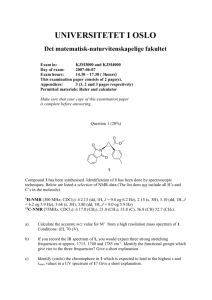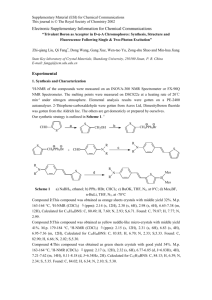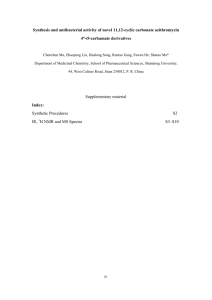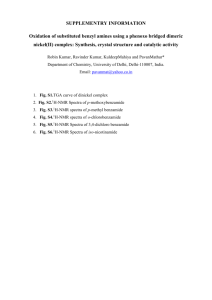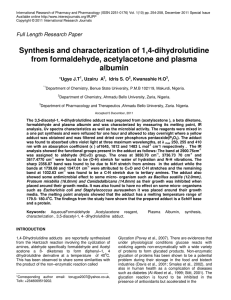Lipase catalyzed condensation reaction of 4
advertisement
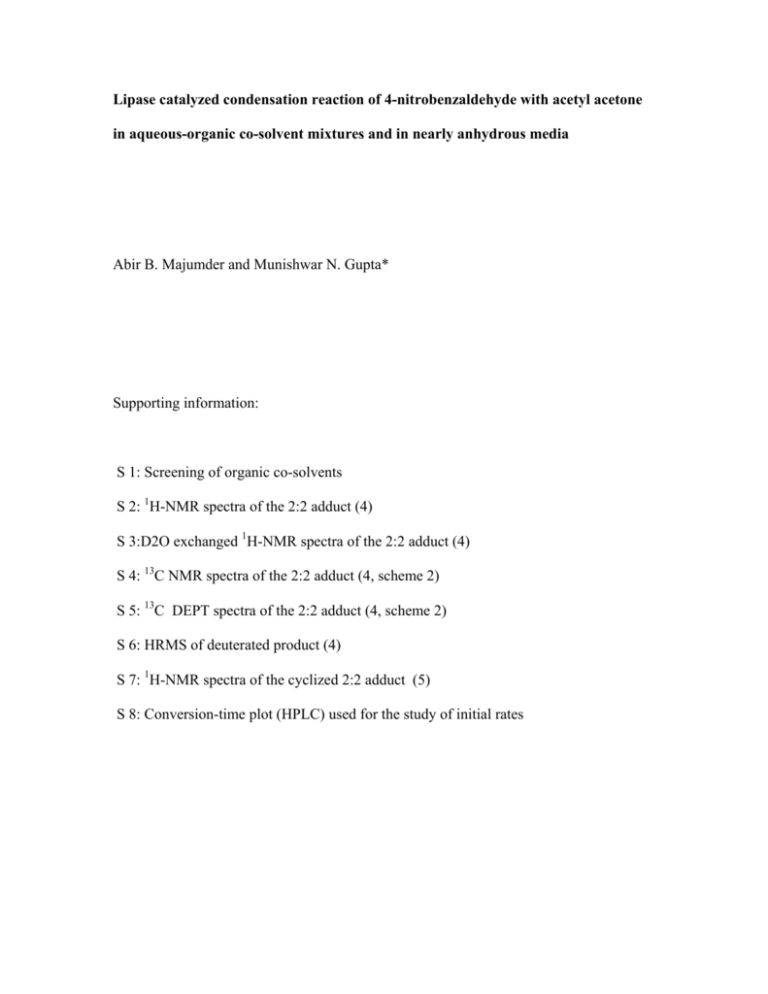
Lipase catalyzed condensation reaction of 4-nitrobenzaldehyde with acetyl acetone in aqueous-organic co-solvent mixtures and in nearly anhydrous media Abir B. Majumder and Munishwar N. Gupta* Supporting information: S 1: Screening of organic co-solvents S 2: 1H-NMR spectra of the 2:2 adduct (4) S 3:D2O exchanged 1H-NMR spectra of the 2:2 adduct (4) S 4: 13C NMR spectra of the 2:2 adduct (4, scheme 2) S 5: 13C DEPT spectra of the 2:2 adduct (4, scheme 2) S 6: HRMS of deuterated product (4) S 7: 1H-NMR spectra of the cyclized 2:2 adduct (5) S 8: Conversion-time plot (HPLC) used for the study of initial rates 90 80 70 Conversion (%) 60 50 40 30 % DMF 30 % Dioxan 30 % DMSO 30 20 10 0 0 20 40 60 80 Time (h) S 1 Screening of organic co-solvents for the lipase catalyzed synthesis of 4: 4Nitrobenzaldehyde (100 mM), acetylacetone (100 mM), 20 mg Lipase (Mucor Javanicus lipase), in presence of co-solvents (30 % v/v, required to dissolve the aldehyde and acetylacetone in 1 mL buffer) were shaken at 200 rpm at 30 °C. Aliquots were taken out at different time intervals and were analyzed by HPLC. Each experiment was performed thrice and the deviation between the individual values within ± 2%. 2 ppm S 2 1H-NMR spectra (CDCl3, 300 MHz) of the 2:2 adduct 4. 3 S 3 D2O exchanged 1H-NMR spectra (CDCl3, 300 MHz) of the 2:2 adduct 4. The enolic protons (at δ 5.3 ppm) were disappeared by deuterium exchange. 4 S 4 13C- NMR Spectra (CDCl3, 300 MHz) of the 2:2 adduct 4 5 S 5 13C DEPT NMR (CDCl3, 300 MHz) Spectra of the 2:2 adduct 4 indicating a total of five types of carbons bearing odd number of hydrogen atoms. 6 S 6 HRMS data of the product 4 (deuterated). m/z 509.3036 (M+ NaC24H22 D2 N2O9 requires 509.2027). The peak at 507.2543 was due to the mono deuterated 4 which occurred with the proton exchange in methanol solution which was used as the solvent for mass spectral analysis. 7 S 7: 1H-NMR spectra (CDCl3, 300 MHz) of the cyclic 2:2 adduct 5. The two enolic protons (at δ 5.3 ppm, S 2) of 4 are missing showing removal of these two protons via ring closure. The peak at δ 1.5 ppm is a moisture impurity. 8 100 100 Acetonitrile 90 1a Acetonitrile Acetylacetone CPME DMSO DCM t-butly alcohol t-amyl alcohol 90 Acetylacetone 80 CPME 80 DMSO 70 DCM t-butyl alcohol 60 Conversion (%) Conversion (%) 70 1b t-amyl alcohol 50 40 30 60 50 40 30 20 20 10 10 0 0 20 40 60 Time (h) 80 0 0 20 40 60 80 Time (h) S 8. Effect of diffferent organic solvents on the synthesis of 4 (Fig 1a) and 3 (Fig 1b) from acetylacetone and 4-nitrobenzaldehyde in low-water media. 4-Nitrobenzaldehyde (0.1 M), 20 mg lipase formulation was taken in 1mL of various dried organic solvent along with acetylacetone (0.1 M or in excess in solvent free case) and were shaken at 200 rpm at 30°C. Each experiment was performed thrice and the deviation between the individual values within ± 2 %. 9
